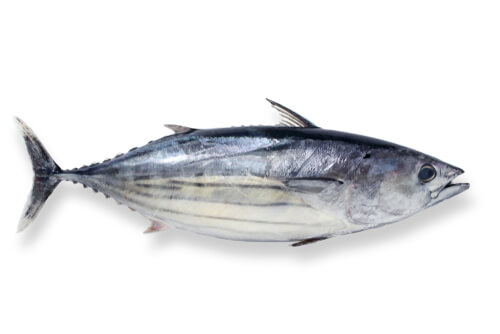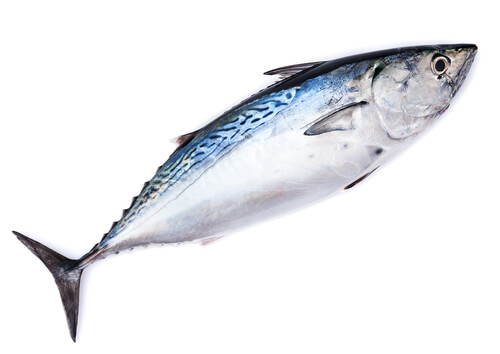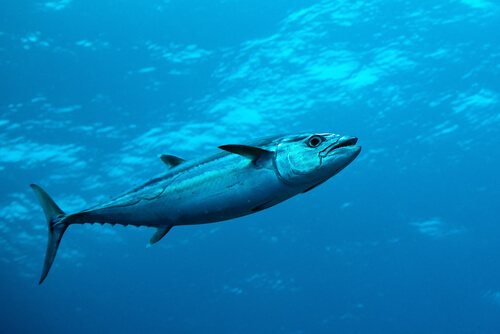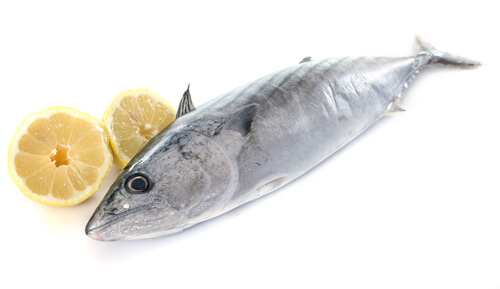
| Kingdom | Animalia |
| Phylum | Chordata |
| Class | Actinopterygii |
| Order | Scombriformes |
| Family | Scombridae |
| Genus | Sarda, Gymnosarda, Orcynopsis, Cybiosarda |
| Species | 8 total (5 in genus Sarda) |
| Niche | Non-pelagic predator |
| Length | 20-100 in (45-230 cm) |
| Weight | 5-250 lb (3-130 kg) |
| Lifespan | 8-12 years |
| Social Structure | Schooling predator |
| Conservation Status | Least Concern |
| Preferred Habitat | Cosmopolitan (depending on species) in tropical and subtropical waters |
| Average Clutch Size | Millions of eggs |
| Main Food Items and Prey | Fish, crustaceans, squids, etc. |
| Predators | Other tuna species, toothed whales, sharks, sea lions, seals |
The Basics
Bonito refers to a group of medium-sized predatory fish belonging to the same family as tuna and mackerel. There are four genera of bonito, comprised of a total of eight species. The Pacific bonitos (Sarda chiliensis chiliensis, S. c. lineolata) and the Atlantic bonito (S. sarda) are perhaps the most commonly known species. Other species in this genera include the striped bonito (S. orientalis) and the Australian bonito (S. australis). Additionally, the dogtooth tuna (Gymnosarda unicolor), plain bonito (Orcynopsis unicolor), and the leaping bonito (Cybiosarda elegans) are each the only species in their respective genera.
Description
All species of bonito have a similar appearance, with a torpedo-shaped body and a large caudal or tail fin. Some species such as the Pacific bonito closely resembles the skipjack tuna, which itself is sometimes referred to as the oceanic bonito. They grow to a similar size of around 20 pounds and about 40 inches long. The smallest species of bonito is the leaping bonito, which grows to around 20 inches long and weighs about 5 pounds. In contrast, the dogtooth tuna is the largest of all members of the bonito Tribe, weighing as much as 250 pounds and growing as long as 100 inches.

All species have some combination of silver and dark grey or blue, the latter generally being on their dorsal sides, becoming lighter towards their ventral side. Some species feature striped patterns along their flanks. The base of their tails is narrow, with each the top and bottom side being lined by small finlets between the rear dorsal and anal fins and the tail fin. They have two dorsal fins and two small pectoral fins, along with a large, conical head featuring a large mouth and eyes.
Range
Bonitos are found throughout the world’s oceans, particularly in tropical and subtropical waters as well as temperate waters in a few instances. All members of the genus Sarda are particularly similar, with the eastern Pacific bonito and the pacific bonito often considered subspecies of each other rather than distinct species. It is their range that primarily distinguishes them. Similarly, the Atlantic bonito and Australian bonitos are found throughout the Atlantic and Indian oceans, respectively, although their morphological genealogical distinction from the Pacific bonitos is better defined.
The dogtooth tuna is more cosmopolitan, with populations occurring in most tropical waters including the Red Sea. The plain bonito has a distribution more similar to the Atlantic bonito, occurring in the Eastern Atlantic from Norway all the way to Senegal as well as the Meditteranean and Black Seas. Finally, the leaping bonito occurs in a more limited area around northern Australia and south of New Guinea. Due to its range and similarity to ‘true tunas’, it is often referred to as the Australian tuna, further complicating the taxonomy of the bonito tribe as well as the tuna and mackerel family, Scombridae, in general.
Distribution and Habitat
In general, bonito and other members of the family Scombridae inhabit the nearshore and offshore areas and spend most of their time relatively near the surface. Young individuals of most species may spend most of their time in shallow reef environments whereas older individuals may venture just offshore to nearby but deeper habitats. Like other tuna species, they do often dive to impressive depths. This behavior tends to occur in a diurnal pattern, where they will move deeper during the day and closer to the surface after sundown. This likely occurs as they pursue prey such as squid which are also known for this same behavior.
Diet and Predators
Like their close relatives, tuna, bonito are muscular and streamlined predators. They will feed on a variety of prey, primarily smaller fish, by ambushing schools or shoals as well as lone individuals when possible. They will also eat various other species such as pelagic crustaceans and cephalopods such as squid.

In turn, all species of bonito are subject to predation by other marine predators. Although they are fast, they are not always able to outswim other predators such as larger tuna and billfish as well as toothed whales including dolphins and orca. Sharks such as the mako shark, blue shark, great white shark, and more will also hunt bonito.
Reproduction
Most species of bonito spawn throughout the year, with some seasonality observed with variation between species and populations, particularly in subtropical and temperate regions. For example, Pacific bonito are known to spawn between January and May while Atlantic bonito generally spawn during the northern hemisphere summer, from June-September. Nearer the equator, bonito and other similar fish species generally spawn year-round.
Bonito are broadcast spawners, with both species releasing their gametes (eggs and sperm) into the water column in synchrony where external fertilization occurs. The embryo will then float with the plankton community for several days before developing into a larval fish and, eventually, a juvenile bonito, capable of hunting prey of its own. Most individuals are sexually mature within 2 years and live for roughly 8-12 years, depending on the species.

Although some populations face threats from pollution and overfishing, most bonito stocks remain relatively healthy. As a result, they are listed as Least Concern by the IUCN Red List of Threatened Species.
Fun Facts about Bonito!
Although not as well known as the closely-related tuna, bonito form an important part of the food chain around the world and are a popular commercial and sport fishery target as well. With much in common with their larger cousins, bonitos are equally as impressive and fascinating as tuna, with many fun facts to explore.
Fast Fish
Due to their streamlined shape and muscular form, bonito are particularly fast fish. Some species are capable of swimming up to 40 mph which, for their relatively small size, is indeed impressive.

Their speed is due largely to some specific physiological adaptations common to the Scrombidae family. First, they are lean, strong fish with large bands of muscles running down each of their flanks. They also have a large caudal or tail fin, which propels them. In combination with their strong muscles which help to keep the body rigid while their tail moves side-to-side, they are able to efficiently translate that effort into rapid acceleration and impressive top speeds. These traits are, of course, helpful in both the pursuit of prey and the evasion of predators.
All Growing Up
The timing of spawning events varies between species as well as between populations of the same species found in different temperature regimes. In most cases, bonito become sexually mature around the age of two, although this also remains somewhat dependent on temperature and other conditions.
Older bonito are known to become ready to spawn earlier in the season than younger fish, while fecundity increases with size as well. It is estimated that a roughly five-pound female bonito may produce approximately 500,000 eggs within one spawning season. These eggs are produced in batches and released accordingly once ready.
Not Exactly Apex
An apex predator is a predator with few if any natural predators in its normal environment and ecosystem. Many perciforms such as swordfish and billfish, for example, are unquestionably apex predators, with the size and speed precluding them from predation by virtually all other species.
Within the Scrombidae family, however, this distinction is not so clear. In the case of the bluefin tuna, which can grow to enormous sizes, it is also an apex predator. Smaller species, however, such as the albacore tuna, fill a similar niche as the bluefin but are also subject to predation by larger animals. This includes predation by larger species of tuna.
Within the same family, the bonito tribe is also not easily distinguished as ‘apex’ or not. Although most species are subject to predation by larger fish in their environment, the dogfish tuna is an apex predator. Being much larger than all other members of the tribe, this is not particularly surprising. Unlike the rest of the group, this opportunistic feeder has few regular predators in the near-reef environments it is known to inhabit.
